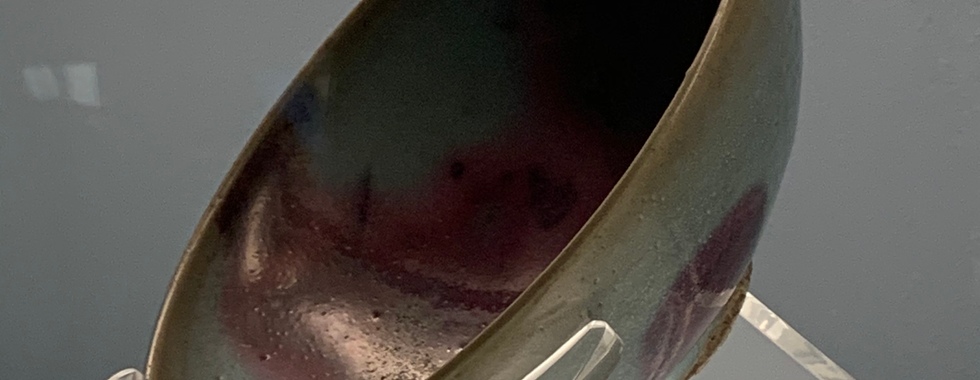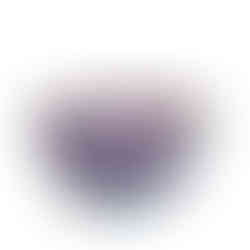
SACA學會 宋代筆記 vol.18 鈞窯藍釉紅斑碗 上海博物館藏
高7.7釐米,口徑18.65釐米,足徑5.4釐米
這件鈞窯碗通體釉色為天藍色,其上顯現幾塊紫紅斑塊,上有鐵質斑點結晶。此碗造型別緻,宛如一朵盛開的花朵,嫵媚多姿。藍、紫相間的釉色,又如同天空中飄浮的彩雲,這件作品的特點是紫紅斑十分的飽滿,這也是收藏家爭相追逐的特徵之一。

而在宋代以前,中國的瓷器多以單一的青釉做裝飾,而鈞紅的燒製成功則開創了一個新的境界。不規則的紫斑在當時深受文人和貴族的喜愛,他們能夠欣賞簡約、謙遜和抽象,與大多數地區和時期更喜歡奢華材料和華麗設計的貴族形成鮮明對比。在這個罕見的例子中,起伏的紫色斑點與淡綠色的微妙亮點形成鮮明對比,與明亮的薰衣草藍釉相映成趣,彷彿抽象繪畫的美麗,誘人近距離審視其永恆和自然的魅力。
儘管鈞瓷呈現的紅色還帶有深淺不一的紫紅色斑塊,但它仍然是一個重大成就,對後來陶瓷發展產生了深遠影響,特別是為元、明、清各時期高溫顏色釉的發展奠定了基礎。這樣的碗斂口,深弧腹,圈足。里、外施天藍色釉,上有紫紅斑,勻淨光潤。圈足端無釉露胎,呈褐色,質地堅致。
鈞窯以其迷人的紫藍色調而聞名,始燒於宋代,可能從北宋末期(960-1127年)一直延續至至少明代(1368-1644年)。窯口方面是由河南各地的許多窯口生產的,包括禹州的鈞台窯和寶豐的清涼寺汝窯。其技術特徵是在釉里摻有銅的氧化物,用還原焰燒出絢麗多彩的窯變釉。鈞窯系瓷器的燒造地點很廣,河南的禹縣、郟縣、登封、新安、湯陰、安陽,以及河北的磁縣等都有燒造。
這只傑出的碗出自宋代五大名窯,也是中國歷史上最大膽的創作之一。鈞窯在世界各地的知名收藏中佔有重要地位,如倫敦的大英博物館和北京的故宮博物院。它們還出現在著名的拍賣會和私人收藏中,包括Percival David爵士的收藏、日內瓦的鮑爾收藏和仇焱之收藏等,突顯了它們在中國陶瓷領域的重要性和持久吸引力。
同款參考:
1. 北京故宮博物院【钧窑天蓝釉红斑花瓣式碗】
新00062723
钧窑天蓝釉红斑花瓣式碗,宋,高4.8厘米,口径9.5厘米,足径3.5厘米。 碗呈花瓣状。口内敛,器里凸起、器外凹进10条棱线,将碗自然分成十花瓣形,圈足。通体釉色为天蓝色,其上显现几块紫红斑块,上有铁质斑点结晶。 此碗造型别致,宛如一朵盛开的花朵,妩媚多姿。蓝、紫相间的釉色,又如同天空中飘浮的彩云。 我国的瓷器在宋以前多以单一的青釉做装饰,钧红的烧制成功则开创了一个新境界。虽然钧瓷所呈现的红色还杂以或深、或浅、或呈斑块状、或呈放射状的紫红色,并非纯正的红色,但它仍然是一个重大成就,对后来陶瓷发展产生过深刻影响,特别是为元、明、清各时期高温颜色釉的发展奠定了基础。
2. 藍理捷鈞窯碗 the Jim Lally Jun
A FINE AND RARE PURPLE-SPLASHED ’JUN‘ BOWL NORTHERN SONG/JIN DYNASTY | 北宋/金 鈞窰藍釉紫斑小盌
Auction Closed / BI 流拍
Sotheby's 2019 November 7, 02:16 AM CST
Estimate: 100,000 - 150,000 GBP
the well potted rounded sides rising to a gently incurved rim, liberally applied to the interior with a large splash transferring from a lavender tone to a rich purplish-red tone, covered overall with a pale-blue glaze suffused with a matrix of pale crackles thinning to a buff tone at the rim and stopping just above the neatly-cut foot
Diameter 12.7 cm, 4⅞ in.


Provenance
Collection of Dr and Mrs Marvin L. Gordon, San Francisco.
J.J. Lally & Co. Oriental Art, New York, September 2009.
Marvin L. Gordon 醫生伉儷收藏,三藩市
J.J. Lally & Co. Oriental Art,紐約,2009年9月
Exhibited
J.J. Lally & Co. Oriental Art, The Gordon Collection: Chinese Ceramics and Works of Art, New York, 2009, cat. no. 28.
J.J. Lally & Co. Oriental Art,《The Gordon Collection: Chinese Ceramics and Works of Art》,紐約,2009年,編號28
Purple-splashed 'Jun' wares are remarkable for their splendid colouration, which display a range of blue and lavender tones. The red derives from a copper-rich pigment brushed to the blue glaze, which is difficult to control in the firing and thus particularly unpredictable in its outcome.This chance effect is part of the ware’s attraction, giving each piece with distinct identity, with individual patterns and tonal variations created as if by nature. Irregular purple splashes had an immense appeal to the literati and nobility of the time, who was able to appreciate simplicity, modesty and abstraction as opposed to the aristocracy in most regions and periods who preferred extravagant materials, lavish designs. In this particular rare example, the undulating purple splashes complemented by subtle highlights of leafy green provide an attractive contrast against the bright lavender-blue glaze underneath, simulating the beauty of abstract paintings, enticing one for an intimate inspection of its timelessness and spontaneity.
This noble bowl belongs to one of the five celebrated Song wares and at the same time one of the most daring creations China’s history. 'Jun' ware, with its entrancing purple-and-blue colour combination, was produced by many different manufactories in Henan, including the Juntai kilns in Yuzhou and even at the Ru kilns at Qingliangsi in Baofeng, probably from the end of the Northern Song period (960-1127) until at least the Ming dynasty (1368-1644).
Jun ware bowls are represented in world-famous collections, such as the British Museum, London, from the collection of Sir Percival David, illustrated in Margaret Medley, The Chinese Potter, Oxford, 1976, fig. 83, and in the Palace Museum, Beijing, published in The Complete Collection of Treasures of the Palace Museum. Porcelain of the Song Dynasty (I), Hong Kong, 1996, pl. 225. Compare also two bowls in the Baur Collection, Geneva, included in John Ayers, The Baur Collection, Geneva; Chinese Ceramics, vol. 1, Geneva, 1968, nos. A31 and A32. Two bowls from the Edward T. Chow collection, amongst the best extant examples, were sold in our London rooms, 16th December 1980, lots 264 and 265, and again in these rooms, the former on 19th May 1987, lot 209, and later in the T.T. Tsui collection; the latter on 7th June 2000, lot 93.
3. 亞歷山大鈞窯碗 the Alexander Jun
Lot 3605. An outstanding Jun purple-splashed bowl, Northern Song – Jin dynasty, 12th – 13th century; 14.9 cm. Lot sold 7,560,000 HKD (Estimate : 6,000,000 - 8,000,000 HKD). © Sotheby's 2022
Provenance: John Audley, Berkeley Square, London, 1911 or earlier.
Collection of William Cleverly Alexander (1840-1916), bought 13th June 1911 for £300.
Collection of the Misses Alexander.
Sotheby's London, 6th/7th May 1931, lot 145 (£370).
Collection of Sir Rex Benson (1889-1968).
Collection of Mrs Rex Benson (1907-1981).
Sotheby's London, 14th April 1953, lot 143.
Sydney L. Moss, London, 1953.
Collection of Raymond F.A. Riesco (1877-1964), no. 102v.
Collection of the London Borough of Croydon (c.1959-2013).
Christie's Hong Kong, 27th November 2013, lot 3103.
Literature: R.L. Hobson, Bernard Rackham & William King, Chinese Ceramics in Private Collections, London, 1931, col. pl. 2.
London Borough of Croydon, Riesco Collection of Chinese Ceramics. Handlist, Croydon, 1987, p. 7, no. 52.
Regina Krahl, ‘China Without Dragons. An Exhibition of The Oriental Ceramic Society’, Orientations, November/December, 2016, p. 96.
Jane Sze, ‘Some Forms and Uses of Jun Wares’, Arts of Asia, November-December 2020, vol. 50, no. 6, pp. 112-17, fig. 4.
Jane Sze, The Rainbow Aloft: Jun Ware, Hong Kong, 2020, pl. 9.
Rose Kerr, Dazzling Official Jun Wares: From Museums and Collections Around the World, Woodbridge, Suffolk, 2021, p. 38, pl. 18.
Exhibited: Ausstellung Chinesischer Kunst, Gesellschaft für Ostasiatische Kunst und Preußische Akademie der Künste, Berlin, 1929, cat. no. 564.
The Town Hall and later the Clock Tower, Croydon (after 1964 until 2013).
China Without Dragons. Rare Pieces from Oriental Ceramic Society Members, The Oriental Ceramic Society, London, 2016, cat. no. 76.
The Alexander Jun Bowl
Regina Krahl
Purple-splashed Jun wares from kilns in Juntai, Yu county, Henan province, are arguably the most striking and flamboyant ceramics made in China during the Song (960-1279) and Jin (1115-1234) periods, and at the same time among the most contemporary in design. Among this art-historically outstanding production, the ‘Alexander Jun bowl’ is one of the most successful and impressive pieces. Its superbly proportioned shape spells balance and harmony, its extremely vivid colouration and abstract glaze pattern add dynamic and tension. Its size is exceptional. The well-rounded profile invites the viewer to pick the bowl up with both hands, the asymmetric pattern makes it compulsory to turn it around.
Song connoisseurs were extremely advanced in their taste. The Song ruling elite, right up to the imperial court, was able to appreciate simplicity, abstraction and a certain rustic beauty. Only thus can one explain the high regard nearly a millennium ago, for a vessel such as this bowl, which could be the work of a contemporary artist.
‘Jun’ ware, with its ravishing purple-and-blue colour combination, is one the most daring creations in the history of Chinese ceramics and certainly the most flamboyant of the major wares of the Song dynasty (960-1279). This period, which can be regarded as the first classic age of Chinese ceramics, saw a particularly large number of outstanding kiln centres throughout China compete for attention. No other manufactory achieved similarly bold and colourful results. Nigel Wood discusses the uniqueness of Jun glazes, which derive their bright sky-blue glaze colour not from a pigment but from an optical illusion – indeed not unlike the blue of the sky – as minute spherules of glass in the glaze are scattering blue light. He writes “… the fully developed Henan Jun glaze was a high-fired effect unique to China ... In addition to accurate mixing and careful selection of raw materials, Henan Jun glazes also needed unusually long firings and slow cooling for their special characters to develop.” (Nigel Wood, Chinese Glazes. Their Origins, Chemistry and Recreation, London, 1999, p. 119 and p. 125). The red derives from a copper-rich pigment applied to the blue glaze, which is difficult to control in the firing and thus unpredictable in its outcome. This chance effect is the ware’s particular attraction, making every piece unique, with individual patterns and tonal variations created as if by nature.
The engaging copper-splash pattern on the present bowl comprises three distinct, well-shaped patches on the outside, spaced far enough apart to be well surrounded by plain blue glaze, and giving the bowl very different aspects when seen from different sides. On the inside, the splashes are concentrated around the top, from where they run down in an asymmetric pattern and where they are beautifully contrasted with the pale greenish glaze tone at the rim.
The present bowl is basically unique, but the Palace Museums in Taipei and Beijing have one comparable example each, both of slightly different proportions, with the splashes less clearly defined, and with the foot basically unglazed. The piece in the National Palace Museum, Taipei, is illustrated in A Panorama of Ceramics in the Collection of the National Palace Museum: Chün Ware, Taipei, 1999, pl. 87, pp. 210-11 (fig. 1). Four pages have been devoted to the Palace Museum bowl in Beijing, which is more slender, in Jun ci ya ji. Gugong Bowuyuan zhencang ji chutu Junyao ciqi huicui/Selection of Jun Ware. The Palace Museum’s Collection and Archaeological Excavation, Beijing, 2013, no. 37, pp. 114-17 (fig. 2). A slightly smaller purple-splashed bowl of this elegant rounded form, from the Eumorfopoulos collection is illustrated in R.L. Hobson, The George Eumorfopoulos Collection of Chinese, Corean and Persian Pottery and Porcelain, London, 1925-8, vol. 2, pl. B 78, and was sold in our London rooms, 29th May 1940, lot 185.

fig. 1. A Jun purple-splashed bowl, attributed to the Yuan dynasty, National Palace Museum, Taipei.

fig.2. A Jun purple-splashed bowl, Northern Song–Jin dynasty © Palace Museum, Beijing.
Bowls of similar shape are also known with plain blue glaze, but are very rare with copper splashes. A bowl of similar size is also in the Museum of Fine Arts, Boston, from the collection of Charles B. Hoyt, glazed all in purple on the exterior and on the interior completely covered with sky-blue glaze, illustrated in Wu Tung, Earth Transformed: Chinese Ceramics in the Museum of Fine Arts, Boston, Boston, 1998, pp. 68-9, where the author remarks that besides the dazzling colours “a tea connoisseur of the early twelfth century would most likely also have appreciated the bowl’s sensuous contours and the fullness and thickness of the potting”. All these related bowls differ in their proportions and the style of their splashes, clearly documenting that they were produced individually, independent of the large-scale series production the Juntai and other kilns were engaged in at the same time.
With its well-shaped silhouette and strong colouration, the Alexander Jun bowl is closely reminiscent of the famous Jun ‘bubble bowls’, which, however, are much smaller (less than 10 cm) and much less rare. ‘Bubble bowls’ are comparable in the quality of their brightly copper-decorated glazes, their clear splash patterns and their well-proportioned shapes, and also seem to have been individually done; see, for example, a bowl in the Palace Museum, Beijing, in Jun ci ya ji, op.cit., no. 36.
Splashed Jun wares were made by a number of kilns in Henan, but pieces of the best quality, with intense and distinct copper splashes, have been recovered particularly from the Yuxian kilns. Related fragments from the kiln site are illustrated in Gugong Bowuyuan cang Zhongguo gudai yaozhi biaoben [Specimens from ancient Chinese kiln sites in the collection of the Palace Museum], vol. 1: Henan juan [Henan volume], Beijing, 2005, book 2, pls 445-7, but most of them probably deriving from the smaller ‘bubble bowls’.
While larger splashed Jun bowls exist, they tend to be of much lower quality overall, lacking the concise form of the present piece with its neat incurved rim as well as the striking colouration and are generally of later date, being products of the Yuan dynasty.
Due to its outstanding beauty, quality and rarity, this bowl has become known as the ‘Alexander Jun bowl’, after its first known collector in the West, William Cleverley Alexander (1840-1916). Alexander was a British banker, avid art collector and patron, and himself an accomplished water colourist. His father was a founding member of the British and Foreign Anti-Slavery Society. He was an early patron of the American painter James McNeill Whistler (1834-1903), who when living in the UK was involved in the decoration of Alexander’s London residence, Aubrey House at Holland Park, and portrayed three of Alexander’s daughters. Two of these paintings, of Miss Cicely Alexander and Miss May Alexander, were donated to the Tate Gallery (Tate Britain), London, of which the former, titled Harmony in Grey and Green, became one of Whistler’s most celebrated paintings. Alexander was a founding member of the National Art Collections Fund in Britain, member of the Burlington Fine Arts Club and generously loaned pieces to exhibitions. Besides paintings, he collected in particular Chinese and Japanese works of art. The most famous piece of Alexander’s important Chinese collection, the ‘Alexander Bowl’, is one of the scarce extant examples from the Zhanggongxiang kilns of Ruzhou (Regina Krahl, “The ‘Alexander Bowl’ and the Question of Northern Guan Ware”, Orientations, November 1993, pp. 72-5). R.L. Hobson (Hobson, Rackham & King 1931, p. 3) honoured his collection with the words “The Alexander Collection has a special and almost romantic interest as one of the first of what we may call the modern type of Chinese collections … after assembling a goodly series of the later and more easily obtainable Chinese wares, he turned his attention to the forerunners of these, which were beginning to appear in some quantity in the European market”. Hobson devoted one of the few colour plates in this publication to the present bowl (fig. 3). Alexander bought this bowl in 1911 as a ‘claire-de-lune bowl with red spots’.

R L Hobson, Bernard Rackham & William King, Chinese ceramics in private collections, London, 1931, Col. pl. 2.
Sotheby's. Important Chinese Art including Jades from the De An Tang Collection and Gardens of Pleasure – Erotic Art from the Bertholet Collection, Hong Kong, 29 April 2022




































Comments